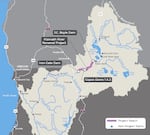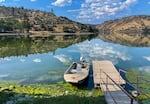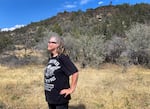Longtime river runner Bill Cross climbed into a raft just below JC Boyle Dam in Southern Oregon.
The guided trip in August 2022 was scheduled to coordinate with PacifiCorp’s power production schedule, so the guides waited to launch until the utility started sending water from the reservoir above through hydroelectric turbines and into the river below.
As it floated downstream, the raft splashed through dozens of rapids with names like “Satan’s gate” and “hell’s corner,” sending waves of water over the rafters in toasty 90-degree heat.
Cross said this plummeting stretch of the Klamath River, sandwiched between two dams, is some of the best summertime class IV whitewater in the West — but it’s unnatural.
“There’s no doubt that what the dams are doing is creating an artificially large pulse of water released in the middle of the day,” Cross said as the raft floated downstream. “And we’re riding that pulse of water.”
When JC Boyle Dam is removed next year, a late August whitewater rafting trip won’t be possible. A switch to more natural river flows is one of many changes in store for the Klamath River through the country’s largest dam removal project that’s currently underway in Southern Oregon and Northern California.

A map of the four dams scheduled to be removed from the Klamath River in Southern Oregon and Northern California.
Klamath River Renewal Corporation
By the end of next summer, four dams will be gone: JC Boyle, Copco 1, Copco 2 and Iron Gate. Their removal is both a source of hope and anxiety throughout the basin, as it will eliminate some awesome summertime whitewater and drain the reservoirs where people currently enjoy living and recreating on lakes.
But it will also reopen hundreds of miles of salmon habitat that could be a lifeline for the threatened fish that are vital to Native American cultures throughout the Klamath Basin. It will also restore thousands of acres of land, some of which could be returned to Native American tribes such as the Shasta Indian Nation, whose members were displaced by dam construction more than 100 years ago.
The possibility of salmon returning to the Upper Klamath River raises questions about whether the $450 million dam removal project could inspire other changes in Southern Oregon, where tribes, farmers and ranchers are all suffering from chronic water shortages and related environmental problems.
Many are still mourning the death of the hard-fought Klamath Basin Restoration Agreement, which was the original plan for dam removal that included a negotiated settlement balancing the basin’s many needs for water and ecological restoration. It died when Congress failed to approve it, but new plans are emerging to revive more of the extensive wetlands that were drained for agriculture, improve the way farmers use water and help the endangered suckerfish that the Klamath Tribes used to depend on.
In the meantime, residents of the basin wait to see how the dam removals will reshape this landscape.

A rafting trip on the Upper Klamath River in June 2022 on water released from JC Boyle Dam in Southern Oregon. After dam removal, summertime water levels in the Klamath River will drop to a more natural flow.
Brandon Swanson / OPB
‘Losing a good friend’
When JC Boyle Dam is removed next year, there won’t be enough water in the river in late summer for big rafts to float over boulders without getting stuck.
That’s bad news for Noah’s River Adventures rafting guide Bart Baldwin, whose business depends on summertime trips that will no longer be possible.
“I feel like I’m losing a good friend,” he said. “I’ve run this river a lot, and it’s my favorite. It’s fun. It’s exciting. It’s challenging. It just feels like home.”
Baldwin will have to rearrange his business model next summer, but he and other rafters also see the benefits of dam removal.

White foam builds up on the edges of the Klamath River in August 2022 because of pollution that builds up in stagnant water in dam reservoirs.
Brandon Swanson / OPB
As he floated downstream, Cross pointed out evidence of water quality problems tied to stagnant reservoir water that will be improved — piles of pillowy white foam and bright green algae blooms that worsen with pooled agricultural runoff.
“When these dams come out, people are going to get a firsthand look at a river restoring itself to a natural condition,” Cross said. “And one of the best ways to see that will be to raft, kayak, or canoe.”
Losing Copco Lake
The Klamath dam removal project took decades to get approval — in part because it’s controversial.
Opponents warn of problems that could come from releasing the sediment stored behind the dams, and many don’t want to lose the reservoirs where people live and recreate.
Francis Gill and Danny Fontaine are longtime residents of Copco Lake, where about 75 houses line the reservoir. They fought against dam removal because they’re worried about losing the water body their community is named after.

Copco Lake residents Francis Gil, left, and Danny Fontaine stand on a dock in May that they have to remove so that Copco Lake can be drained for dam removal.
Brandon Swanson / OPB
The couple recently bought the shuttered Copco Lake store and started renovating it with the hope that their community might thrive in the future — along a river instead of a lake.
“[The store] used to be open, and it was like the hub of the community back then,” Gill said. “We’re hoping we can bring that back.”
Perhaps future river rafters could stop in for a bite to eat, they said.
When the reservoir is drained, Gill and Fontaine will lose their docks and easy boat rides on the lake, and they don’t know what to expect from the bare land and the river that will replace it.
“People are angry and sad because, you know, we’re suffering a loss,” Gill said. “We’re going through this grief process for like … 21 years up here.”
Fontaine said his job as a real estate agent is harder now because Copco Lake homes will lose some property value without the lake, and they also could see damaged water wells and unstable ground when the reservoir is drained and sediment stored behind the dams starts flowing downstream.
“Nobody knows what it’s going to be like,” Fontaine said. “So when you’re trying to sell a home to somebody and you can’t tell them what they’re buying, it creates a big challenge.”
“Now he has to disclose, ‘Well, your well may dry up, or your house may fall off a cliff,’” Gill said. “‘Oh, yeah. By the way, the lake’s going away in a few months too. Welcome!’”

The reservoir above Copco 1 Dam, known as Copco Lake, will be drained before dam removal, exposing land that may be returned to the Shasta Indian Nation.
Cassandra Profita / OPB
‘We want our land back’
For members of the Shasta Indian Nation, draining Copco Lake will restore some of the land their ancestors lived on for generations with a chance that it will be returned to tribal ownership.
Shasta Cultural Preservation Officer Sami Jo Difuntorum said the land under Copco Lake is part of an area called Kikacéki, where her ancestors lived in tribal villages before they were forced out by dam construction.
“This area represents a lot to us,” she said. “We have a lot of things that are submerged as a result of the dams and the land being taken. Our people were displaced. ... Some of our spiritual areas we haven’t had access to for 100 years since the dams were built.”
Tony Andersen, a spokesman for the California Natural Resources Agency, said the state is talking with the Shasta and several other tribes about acquisition and co-management of the lands along reservoir and dam sites where ownership will eventually be transferred from PacifiCorp to the states of Oregon and California.

Sami Jo Difuntorum, cultural preservation officer for the Shasta Indian Nation, stands in the homeland of her tribe along the Klamath River in Northern California.
Cassandra Profita / OPB
“I think that there is a real positive future here for the tribal culture and having some of our historic practices and ceremonies,” Difuntorum said. “Everybody wants a healthy river. Everybody wants healthy fish. We’re fish people, too. We want that. But we also want ceremony back. We want our land back.”
Replanting the reservoirs
The emptied reservoirs will need a lot of restoration work, and some of that has already started. Workers with local tribes are cutting down weeds and collecting native seeds so they can replant the bare land that’s currently underwater.
“It feels like I’m really making a difference,” said Alauna Grant, a Karuk tribal member working as crew lead for the project. “We’re working right now to get these invasive species out of the way so we can give the native plants a fighting chance to grow and do good.”

Karuk tribal member Alauna Grant, works as crew lead with the Yurok Tribe, gathering native sunflower seeds alongside the Iron Gate Dam reservoir, Sept. 6, 2023. Workers with local tribes are cutting down weeds and collecting native seeds to replant the land exposed following the removal of the dam.
Todd Sonflieth / OPB
Gwen Santos with the ecological restoration company Resource Environmental Solutions is overseeing the job of repairing more than 2,000 acres around the reservoirs and dams.
“After dam removal, we are responsible for putting the river and the ecology and the environment back to a functioning ecosystem,” she said. “I think this is the largest project that any of us have worked on ever.”
Drawdown of the dam reservoirs will begin in January and continue through March. As the water levels drop, crews will begin planting on the exposed land with native seeds, plants and tree saplings. Through collection and propagation in nurseries, the project has amassed 17 billion seeds to use for replanting. More than 1,000 pine trees will be placed by helicopter into the river for fish habitat.
In June, deconstruction crews started removing Copco 2 Dam, which is pretty much gone now. The removal of three much larger remaining dams — JC Boyle, Copco 1 and Iron Gate — will start in June 2024.
Restoring salmon runs
In deciding to remove four Klamath River dams, the utility PacifiCorp weighed the cost of adding fish ladders to allow salmon to swim upstream and found it was far more than the cost of taking the dams out.
The dams weren’t built for flood control or irrigation, said PacifiCorp spokesman Bob Gravely, so removing them will eliminate about 2% of the utility’s total power generation, but it won’t really change the ongoing fights over water scarcity in the Klamath Basin.
“One of the problems on the Klamath is, you know, there’s just lots of demands for a certain amount of water,” Gravely said. “Those disputes will continue after dam removal.”
There’s no guarantee that salmon will thrive in the drought-stricken Klamath Basin after dam removal, but Karuk Tribal Councilman Arron “Troy” Hockaday is hopeful.
He’s been fighting for dam removal for decades — ever since 34,000 salmon died on the Klamath River in a fish kill in 2002.
“By building the dams, they took our fish,” Hockaday said. “Fish is our life — especially on the Klamath River. Our life and our culture. My goal is to fight for those fish and keep fighting for them until I can’t fight anymore.”
Removing the dams will reopen spawning habitat that salmon haven’t accessed for more than a century, and many tribes are working on habitat restoration projects on the Klamath River and its tributaries to create inviting places for the fish to return.

A graphic illustrates the potential salmon habitat in orange that will be reopened after four Klamath River dams are removed.
Andy Adkins / OPB
Hockaday, 52, said one day he’ll be too old to fish, and he’s hoping to see his grandson catch a salmon for him.
“By removing these dams, there’s a glimmer of hope that I will have that enjoyment to sit there and wait for that fish,” he said.
Last year, Mark Hereford with the Oregon Department of Fish and Wildlife started working with the Klamath Tribes to tag young hatchery salmon from the Trinity River in California and release them above the four Klamath River dams to study how the fish use the habitat.
This fall, he plans to release up to 10,000 spring chinook in the Williamson and Wood River tributaries, where adult salmon could eventually swim up the Klamath River to spawn after the dams are removed.
Eventually, Hereford and the Klamath Tribes are hoping to start a new run of salmon that will spawn in the Upper Klamath Basin and have a clear path to the ocean and back.
“We have habitat,” Hereford said. “We just want to repopulate it.”
Rafting Ward’s Canyon
Longtime river runner Bill Cross already knows where he wants to go rafting after dam removal. It’s known as Wards Canyon, and it’s a sacred place for Shasta people who once lived there.
The river channel in this steep basalt canyon used to be filled with rushing water, but it was drained when Copco 2 Dam was built. After dam removal, it will have water flowing through it again for the first time in a century.
A few years ago, Cross had a chance to preview what the canyon will look like after dam removal when PacifiCorp diverted water into the channel to simulate future flows. He seized the moment and got into a raft to see what it was like to float it.

River runner Bill Cross stands above Wards Canyon in May, looking down at a stretch of the Klamath River was drained during dam construction.
Brandon Swanson / OPB
“The setting is just exquisite,” he said. “There’s nothing like this on the rest of the Klamath.”
Cross said he can’t wait for the canyon to be part of a long, free-flowing stretch of the river.
“My history with river running and river conservation goes back to a time when we were losing rivers on a regular basis to dams,” he said. “And to have lived long enough to reach a point where we’re actually removing dams and restoring canyons is something I never thought I’d live to see.”



